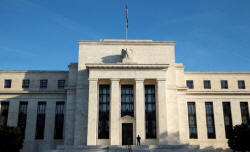|
At the Fed, spring comes
early with return to new 'normal'
 Send a link to a friend
Send a link to a friend
 [March 13, 2017]
By Howard Schneider [March 13, 2017]
By Howard Schneider
WASHINGTON(Reuters)
- U.S. household wealth has hit record levels. U.S. stock prices
recently hit all-time highs. Inflation is nearing the Federal Reserve's
2.0 percent goal, and the world economy including the once-sick eurozone
has skirted the risk of a deep new downturn.
When Fed Chair Janet Yellen holds her first press conference of 2017 on
Wednesday she can arguably declare a victory of sorts with an expected
interest rate rise that will leave monetary policy looking increasingly
normal.
The rate increase expected on March 15 will be the second in four
months, a pace unseen since the peak of the U.S. housing boom in 2006. A
rate hike will also bring the Fed's target rate to between 0.75 - 1.00
percentage points, near the bottom of the range within which the Fed
operated before the 2007-2009 financial crisis.
"You don't need any intrigue or fundamental shifts in beliefs about the
economy to realize why a rate increase might be likely," Johns Hopkins
University professor and former Fed adviser Jon Faust said of the
central bank's plans.
"The Fed would just as soon be back to normal...Unless something really
bad happens they will raise rates in March and that gets them on a path
to raise rates more this year."

U.S. February employment data published on Friday further cleared the
way to an interest rate rise, with the economy adding another 235,000
jobs. The unemployment rate held roughly steady at 4.7 percent.
For Faust and others, the conversation is now focused on whether the
Fed, when it releases new economic forecasts this week, could even raise
its forecast for rate rises also.
The month of March has been cruel to Yellen in the past. At the Fed's
March meetings in 2015 and 2016 the central bank downgraded its economic
forecasts after inflation expectations plunged two years ago and after
last year's meltdown in the benchmark S&P 500 stock index.
A year on, world stock markets have surged and even global economic
laggards like Japan and the euro zone are looking better. European
Central Bank president Mario Draghi gave his own mission accomplished
declaration last week saying that "...our monetary policy has been
successful."
If anything, market analysts, economists, and Fed officials tout the
possibility of stronger economic growth, resulting from the possible
impact of U.S. tax cuts and infrastructure spending, or the run-up in
household wealth from rising stock and real estate values.
As a multiple of disposable income, the $92 trillion in net worth
recorded among American families at the end of 2016 is the highest on
record, JP Morgan economist Michael Feroli noted last week, More
comforting for the Fed, markets have not just anticipated the path of
interest rate rises by setting prices in markets in line with the number
of rate increases for the year that policymakers expect to deliver, but
reacted sanguinely to it.
[to top of second column] |

A police officer keeps watch in front of the U.S. Federal Reserve in
Washington, DC, U.S. on October 12, 2016. REUTERS/Kevin Lamarque/File
Photo

As has
been typical of prior monetary policy tightening cycles, the Fed's moves have
been felt mostly in short-dated bond yields, with less effect on the mortgage
markets or other long-term financing important to economic growth.
That's a relief for a Fed still anxious about events like the 2013 "taper
tantrum", when then Fed chair Ben Bernanke said the central bank would begin
reducing purchases of bonds, triggering a global bond market selloff.
When Fed officials unexpectedly rallied behind a March interest rate increase in
recent weeks, the unusually blunt message was easily accepted. Investor
expectations changed and short-term rates rose.
But
the overall yield curve, the range of interest rates from short to long term
debt maturities, showed little sign investors thought the Fed was becoming
worried about inflation.
Yellen has long made job growth the priority, hoping wage growth would follow,
while assuming the Fed could always tame inflation if it rose too quickly.
While in recent remarks she has emphasized the risk of rising prices, she has
also remained committed to raising rates at only a "gradual" pace in order to
leave loose policy in place a while longer.
IHS chief economist Nariman Behravesh said the latest job report may leave the
Fed in a sweet spot, able to move ahead with its rate hike plans as employment
and modest wage growth continue.

"We can expect to see the recent strength in jobs growth continue for a while
longer," Behravesh said. At an annual rate of 2.8 percent, "while...wage
growth...is nothing to cheer about, it is not bad either."
(Reporting by Howard Schneider; editing by Clive McKeef)
[© 2017 Thomson Reuters. All rights
reserved.] Copyright 2017 Reuters. All rights reserved. This material may not be published,
broadcast, rewritten or redistributed. |